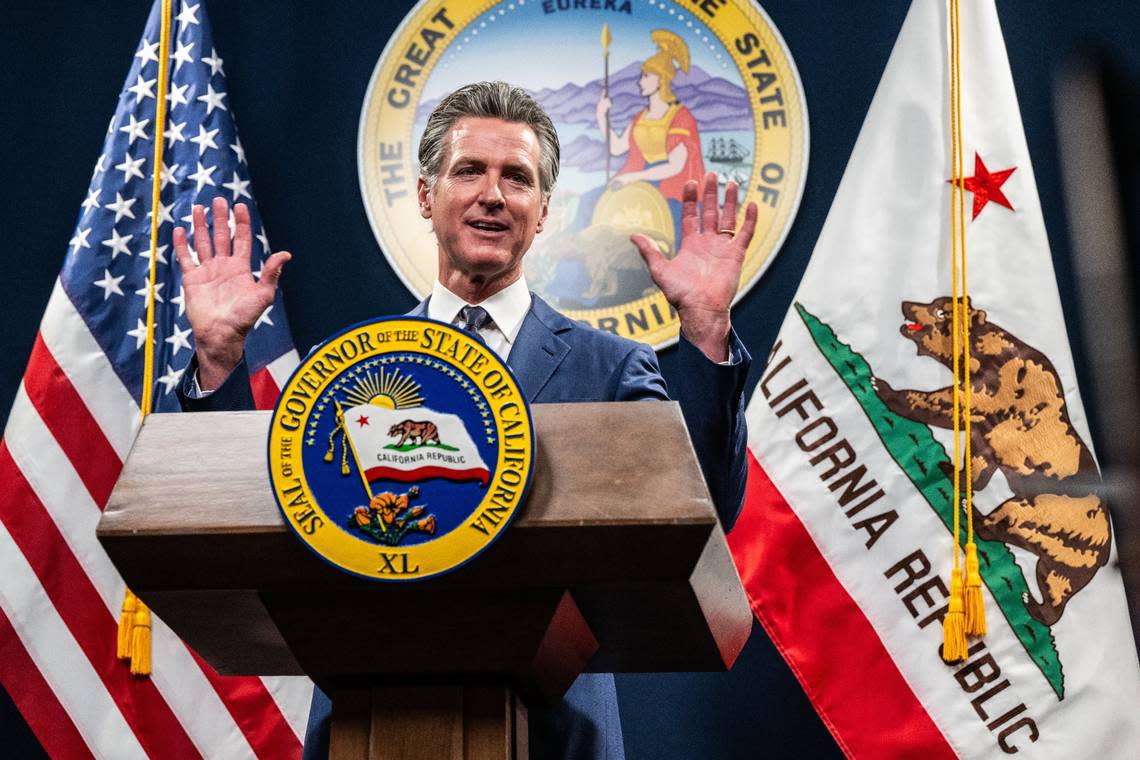California would face larger future budget deficit if savings lag, analysis finds

A nonpartisan California agency is cautioning lawmakers that savings from a cut to state operations proposed by Gov. Gavin Newsom may not materialize and that would pose a larger deficit in the next budget year.
In his budget revisions earlier this months, Newsom proposed trimming state operations -- cuts to nearly all department budgets -- by nearly 8% to save approximately $3 billion a year to deal with an estimated $45 billion budget deficit.
In addition the administration wants to achieve $762.5 million in savings by eliminating 10,000 now-vacant state jobs.
The cuts to state operations would build on a December budget letter Newsom’s Department of Finance sent to all state departments and agencies that enacted a current year budget freeze in anticipation of the looming deficit.
The freeze, among other items, included prohibiting departments from entering into new contracts or agreements, halting discretionary and non-essential IT purchases, unless related to a critical security needs, and canceling non-essential travel.
The administration plans to build on the savings generated from December directive after the final budget is approved by working with state departments and agencies. These reductions in state operations, the governor noted in his budget revision, could include personnel, operating costs and contracting .
However, the precise contours of those reductions will not be known until the final budget is approved, points out H.D. Palmer, a Department of Finance spokesman.
With budget negotiations now ongoing, the Legislature may not agree with Newsom’s Department of Finance exercising the administration’s authority to decide on the cuts in the various state departments and agencies.
Furthermore, “We think there is a high risk that the level of savings assumed” from the proposed reduction measures “will not fully materialize in 2024-25,” the Legislative Analyst’s Office says in its new budget and policy post. “To the extent that savings do not materialize, this proposal would create a larger future budget challenge.”
Newsom’s Department of Finance responded that if the Legislature disagrees with the administration’s proposal, lawmakers would then need to come up with an alternative way to generate the $3 billion in savings the administration expects from trims it wants to work out directly with various departments in the future.
“If the Legislature rejects the governor’s proposal, they’ll have to find $3 billion (in) offsetting savings to make that decision net out,” Palmer said.
The proposed cuts to operations and the estimated annual savings to the budget do not necessarily equate to cutting more staff, Palmer added, although in some departments that may happen even as other areas within those same departments may see in increase in staffing depending on priorities and how to best achieve “operational efficiencies.”
In another analysis, the Legislative Analyst’s Office estimated last week that the administration is addressing a larger budget gap than what it reported in its recently revised spending plan and contends with a $55 billion shortfall for the upcoming fiscal year, which beings July 1.
Overall, the analysis said the governor’s new plan “improves the fiscal health of the state in a number of ways.”
State operation costs have spiked over time
Palmer said the proposed reductions are necessary “as part of the overall plan to close the (budget) shortfall – while at the same time encouraging departments to operate more efficiently in a way that will maintain core operations of state government.”
“We’d note that the proposal recognizes and makes exceptions for specific categories – such as agencies that have 24-hour care or operational requirements, as an example,” Palmer added.
State operations costs have seen significant growth in the last five years, ballooning from $44 billion when the Budget Act was passed in 2019 to a peak of $68 billion in 2021; in 2022 and 2023 those operation costs were over $51 billion.
The administration notes that its proposed reductions acknowledge that the growth in recent years isn’t sustainable for the state’s ongoing budget.
In the coming weeks, the Department of Finance will continue to evaluate the areas where savings can be achieved.
“However, until the Budget Act is passed by the Legislature and approved by the governor, the administration can’t definitively determine all areas for operational efficiencies, since these efficiencies have to take into consideration the full scope of the Budget Act in its final form,” Palmer said in an email.
Legislative Analyst’s Office urges caution
The LAO urged lawmakers to be skeptical that the administration’s proposed state cuts would not affect the service levels at the departments impacted.
“It seems highly unlikely to us that permanently reducing roughly $1 in every $10 spent on state operations would have no effect on services,” the analysis notes.
While Newsom is proposing cuts to state operations expenditures, his revised budget also proposes increases to implement already enacted legislation and other new activities, the LAO says, adding that the “incongruity … is difficult to reconcile.”
“Money is fungible. If the Legislature were to approve both the unallocated reductions and the proposed budget augmentations to fund new activities, what assurances can the administration provide that the newly approved funding and position authority would be used to implement the new activities and not, instead, used to backfill reductions established” by the cuts, the analysis notes.


